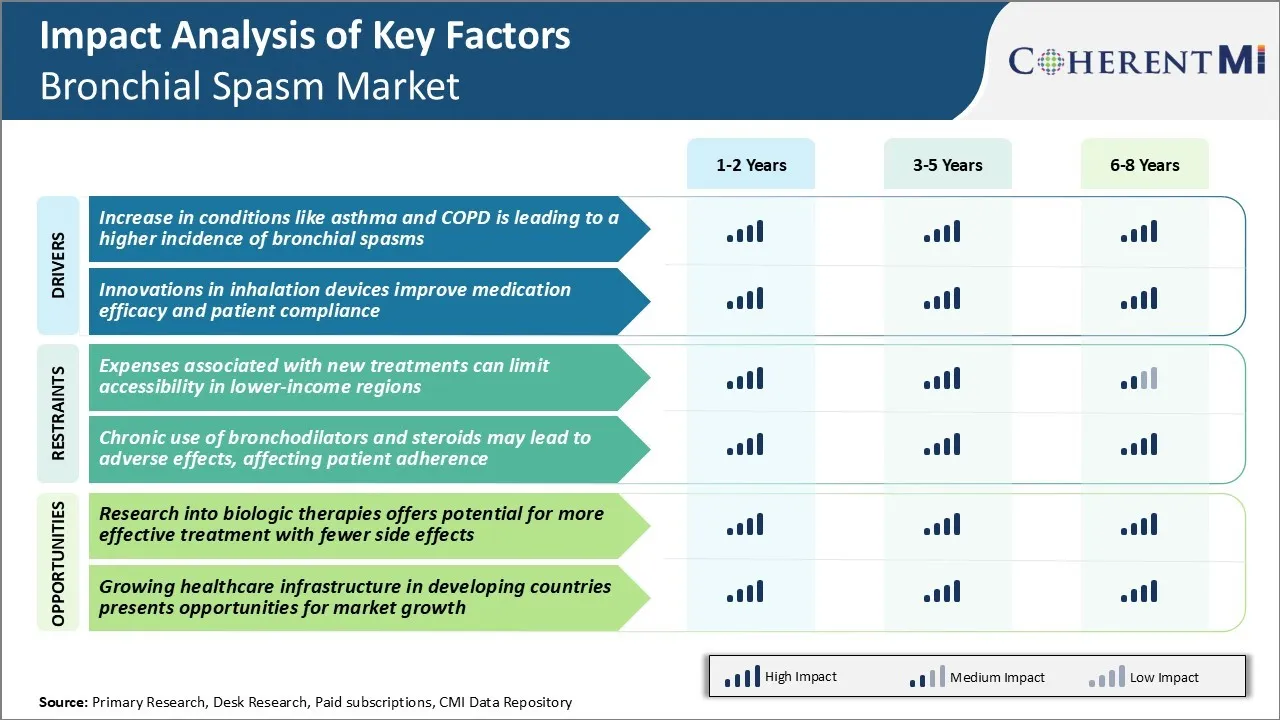気管支痙攣市場 サイズ - 分析
市場規模(米ドル) Bn
CAGR6.1%
| 調査期間 | 2024 - 2031 |
| 推定の基準年 | 2023 |
| CAGR | 6.1% |
| 市場集中度 | High |
| 主要プレーヤー | アストラゼネカ, グラクソスミスクライン plc, ボヘリンガー インゲルハイム, ノバルティスAG, マーク&株式会社 その他 |
お知らせください!
気管支痙攣市場 トレンド
市場ドライバ - 吸入装置におけるイノベーションは、薬効と患者のコンプライアンスを改善する
吸入は、肺への薬物の直接配信による気管支痙攣薬の投与の最も効果的なルートであることが証明されています。 新規のプロペラフリー吸入型インハラー設計による医薬品開発における技術的進歩は、近年増加した治療成功を収めています。
メーターで計られた線量の吸入器、乾燥した粉の吸入器および革新的な公式を利用する噴霧器はより深い肺の浸透および気管支痙攣の速い救助のためのより高い薬剤の集中を保障します。 また、新年齢の吸入器に容易な活発化および線量のカウンターの統合のようなユーザー フレンドリーの特徴は薬剤療法のレジメンへの非常に高められた忍耐強い慰めのレベルそして承諾を持っています。
適切な吸入技術と治療結果間の重要な関係を認識し、デバイス開発者は、防食、直観的機能に焦点を当てています。 利用データを記録し、リマインダーを送信できるスマートインハラーの数が起動しています。 モバイルヘルスアプリや呼吸器モニタリングセンサーで対応するコネクテッドデバイスは、遠隔監視や医師の個別指導を可能にします。
デバイスメーカーとデジタル治療会社との間のパートナーシップは、モバイルプラットフォーム上の遠隔治療サポートによる薬の遵守を強化しています。 さらに、単点乾式粉末吸入器は、長期制御のためのメンテナンス処理スケジュールの遵守を改善しています。

市場機会 - 生態学療法の可能性
気管支スパム市場における1つの機会は、生態学療法への継続的な研究にあります。 科学者たちは、多くの既存の治療オプションのような症状緩和に対処するだけでなく、気管支を運転する基礎炎症プロセスをターゲットとするより効果的な薬を開発するために働いています。 抗体または細胞療法から得られるバイオロジックは、アレルギー喘息における人間の免疫系の誤った反応を正確に調整する見込み客を提供します。
成功すると、これらの新しい生物学的治療は、従来の気化剤と吸入コルチコステロイドと比較して、より少数の副作用とコルチコステロイドを分離するオプションを提供することができます。 バイオマニュファクチュアリングは、コストを削減し、時間をかけてこれらの高度にカスタマイズされた薬のより大きなアクセシビリティを促進するのに役立ちます。 気管支痙攣の機械的理解が進化し続けてきたように、バイオロジックの研究は、世界中の患部の病気管理や結果を変える大きな可能性を秘めています。
処方者の好み 気管支痙攣市場
気管支痙攣は、通常、重症と症状の持続に基づいて、治療の段階的なエスカレーションを通して治療されます。 穏やかな断続的な症状のために、サルブタモール(ベントリン)のような短い作用のベータ2アゴニスト(SABA)は必要に応じて処方されます。 ブロンチョスパルムから迅速な救済を提供するまで、数分でこれらの作業を行います。
症状が週2回以上起こるか、正常な活動を妨げる場合は、コントローラーが追加されます。 低用量の吸入コルチコステロイド(ICS)は、抗炎症作用のために最初に好まれています。 症状が持続的または重症度が増加するにつれて、ICSと長時間作用するβ2アゴニスト(LABAs)の併用は、そのシナジー二重作用のために処方されます。
適度なICS/LABA療法にもかかわらず頻繁な悪化の患者のために、チオトロピウム(Spiriva)のような長時間作用性のmuscarinicの反対者(LAMAs)はレジメンに加えられます。 LAMAsは、24時間制御を提供する別のメカニズムによって働きます。
因子のインフルエンサーの好みは徴候、付着力のパターン、comorbidities、薬物の副作用、使用の容易さ、組合せおよび装置のタイプ両立性の可用性を含んでいます。 特定のブランドとのガイドライン、個々のトレーニング、経験により、好みも異なります。 全体的に、ステップアップのアプローチが一般的に採用され、安全性、有効性、利便性の最適な組み合わせを求めています。
治療オプション分析 気管支痙攣市場
Bronchial spasmは重症度および根本的な原因によって異なる処理することができます。 治療段階は以下の通りです。
マイルドケース:サルブタモールやテルブタリンなどのショートアクションベータ2アゴニストは通常処方されます。 彼らは5〜15分以内に働き、気道の筋肉をリラックスさせます。 Ipratropiumの臭化物のメーターで計られた線量の吸入器はまた単独でまたは短い作用のベータ2のアゴニストと共に使用することができます。
適当な場合: より頻繁か持続的な徴候のために、フラチコンまたはブフェソニドのような吸入コルチコステロイドは好まれます。 それらは気道の炎症を減らし、週に定期的に取られたとき将来の気管支痙攣を防ぐ。 サルメロールやフォモロールなどの長時間作用のベータ2アゴニストも連続した滑らかな筋肉のリラクゼーションのために処方されています。
重症例: 急激な悪化では、すぐに救済を必要とする、サルブタモールのようなショートアクションのベータ2アゴニストが与えられています。 上記の治療にもかかわらず、持続的な症状のために、モンテルカスト錠アグメントエアウェイリラクゼーションなどのレコトリエン受容体拮抗剤は、炎症を軽減します。 Theophylline によって支えられる解放のタブレットはステロイド節約の効果のための別の付加です。
処理し難い場合: 寿命を延ばすケースは、上記に反応しないため、短時間ベータ2アゴニスト、抗コリント、コルチコステロイドおよびマグネシウム硫酸塩の静脈内または皮下投与は、重要なケア設定で緊急気管支障を提供します。
この多段階的なアプローチは気道の滑らかな筋肉および炎症経路の選択的なターゲティングによって気管支痙攣の有効な制御を可能にします。
主要プレーヤーが採用した主な勝利戦略 気管支痙攣市場
競争上の優位性を得るために革新的な製品を開発することに焦点を合わせて下さい: : :
革新的な薬と治療薬の開発は、気管支の市場でトップ選手のための大きな勝利戦略でした。 たとえば、2020年に、Teva Pharmaceuticalは、可逆閉塞性気道疾患に関連した気管支症を治療するために使用されるnebulized levalbuterol HClソリューションの一般的なバージョンを導入しました。 これにより、Tevaは市場の重要なシェアを獲得することができます。
もう1つの例は、2018年に新薬Xopenex HFA(levalbuterol tartrate)を発売したSunovion Pharmaceuticalsで、喘息および慢性閉塞性肺疾患(COPD)に関連した気管支症の治療のための吸入エアロゾルです。
成長のための新興市場に焦点を当てる: : :
プレイヤーは、今後数年にわたって高い成長機会を提供すると予想されるアジア太平洋やラテンアメリカなどの新興市場に焦点を当てています。 例えば、Ciplaは、競争力のある価格で2021年にインドや他のアジア諸国で再利用可能な気管支拡張器をメーターで計った線量吸入器を発売しました。
パートナーシップとコラボレーション: : :
戦略的パートナーシップの構築は、補完的な強みと地理的なリーチの拡大に活用して選手を支援しました。 例えば、ポーランド、ブルガリア、ルーマニア、その他のヨーロッパ市場での過激化イプラトropium臭化インハレーションソリューションの配布とプロモーションのための2017年にフェラーセラピューティクスと提携しました。 これは、両方の企業が売上高と市場浸透を増加させるのを助けました。
セグメント分析 気管支痙攣市場

洞察, 管理のルートで: 使用の消去は、吸入薬の環境設定を増加します。
管理の経路では、吸入は、非侵襲的な性質と肺の経路によって提供される即時の行動に追及する市場の最高のシェアに貢献します。 吸入薬は肺の行為の第一次場所への薬物の直接配達を保障しま、より低い線量とのよりよい治療上の応答を可能にします。 これは、経口および注射可能な処方と比較して、全身の副作用を最小限に抑えます。
吸入装置の中には、移植性や使いやすさにより、メーターで計られた吸入器(MDI)が人気です。 しかし、ドライパウダーインハラー(DPI)は、より少ない調整を必要とするため、市場でのトラクションを獲得しており、すべての年齢層に適しています。 防腐剤のない吸入剤の技術的進歩は、気管支の領域の吸入薬の増加をさらにサポートします。
追加の洞察 気管支痙攣市場
- グローバル影響: 世界各地の約339万人の人々が、気管支に大きな貢献者である喘息に影響を受けています。
- ヘルスケア バーデン: Bronchial Spasmsは、重要な緊急室訪問数のアカウントで、効果的な長期管理戦略の必要性を強調しています。
- 経済コスト: 喘息および関連する気管支の全体的な経済負担は、ヘルスケアコストと失われた生産性のために毎年50億ドルを超えると推定されます。
競合の概要 気管支痙攣市場
Bronchial Spasm Marketで動作する主要なプレーヤーには、GlaxoSmithKline plc、AstraZeneca、Boehringer Ingelheim GmbH、Novaartis AG、Merck&Co.、Teva Pharmaceutical Industries Ltd、Sanofi S.A.、Pfizer Inc。
気管支痙攣市場 リーダー
- アストラゼネカ
- グラクソスミスクライン plc
- ボヘリンガー インゲルハイム
- ノバルティスAG
- マーク&株式会社
気管支痙攣市場 - 競合関係

気管支痙攣市場
(大手プレーヤーが支配)
(多くのプレーヤーが参入し、競争が激しい。)
最近の動向 気管支痙攣市場
- で 8月 2023, GlaxoSmith Kline plc は、重度の気管支の患者のための処置のレジメンを簡素化し、潜在的な付着力および結果を改善する新しい三重の組合せの吸入器を進水させました。 GSKは、以前にトレギー・エリプタ、慢性閉塞性肺疾患(COPD)および喘息を治療するためのトリプルコンビネーション吸入器、吸入性コルチコステロイド(ICS)、長時間作用性の筋動脈硬化症(LAMA)、および長時間作用するβ2-アドレナジスト(LABA)を結合しました。 この吸入器は、COPDのために2017年に承認され、2020年に喘息に拡張され、治療レジメンを1日1回の吸入を簡素化することにより、患者の遵守を向上させるように設計されています。
- 2024年1月、AstraZenecaは、呼吸器疾患に特化したバイオテクノロジー企業を買収し、分子レベルで気管支を標的する革新的な治療でパイプラインを強化することを目指しています。
気管支痙攣市場 セグメンテーション
- 薬剤のタイプによって
- ブロンチョディレータ
- ショートアクションベータ・アゴニスト(SABA)
- ロングアクション・ベータ・アゴニスト(LABAs)
- アンチコリンギックス
- アンチ炎症 エージェント
- 吸入コルチコステロイド(ICS)
- 全身コルチコステロイド
- レコトリエン修飾子
- コンビネーションセラピー
- LABA/ICSコンビネーション
- LABA/ラマ コンビネーション
- ブロンチョディレータ
- 行政のルートで
- インハレーション
- メーターで計られた線量の吸入器(MDIs)
- ドライパウダー吸入器(DPI)
- ネブライザー
- オーラル
- 注射可能な
- インハレーション
- エンドユーザ
- 病院
- クリニック
- ホームケア設定
- 流通チャネル
- 病院薬局
- 小売薬局
- オンライン薬局

購入オプションを検討しますか?このレポートの個々のセクション?
Ghanshyam Shrivastava - 経営コンサルティングとリサーチの分野で 20 年以上の経験を持つ Ghanshyam Shrivastava は、プリンシパル コンサルタントとして、生物製剤とバイオシミラーに関する幅広い専門知識を持っています。彼の主な専門知識は、市場参入と拡大戦略、競合情報、さまざまな治療カテゴリと API に使用されるさまざまな医薬品の多様なポートフォリオにわたる戦略的変革などの分野にあります。彼は、クライアントが直面する主要な課題を特定し、戦略的意思決定能力を強化するための堅牢なソリューションを提供することに優れています。彼の市場に関する包括的な理解は、リサーチ レポートとビジネス上の意思決定に貴重な貢献をします。
Ghanshyam は、業界カンファレンスで人気の高い講演者であり、製薬業界に関するさまざまな出版物に寄稿しています。
よくある質問 :
気管支スパム市場はどれくらいの大きさですか?
気管支痙攣市場は米ドル14.1で評価されると推定される 2024年のBnは、2031年までにUSD 21.7 Bnに達すると予想されます。
気管支痙攣市場の成長を妨げる重要な要因は何ですか?
悪影響を及ぼす可能性がある気管支拡張剤およびステロイドの低所得地域および慢性使用の新治療に関連する費用は、気管支痙攣市場の成長を妨げる主要な要因です。
気管支痙攣市場の成長を運転する主要な要因は何ですか?
喘息やCOPDなどの条件の増加は、気管支のより高い発生率につながる. また、吸入装置におけるイノベーションは、薬物の有効性と患者のコンプライアンスを改善しています。 これらは、気管支痙攣市場を運転する主要な要因です。
気管支痙攣市場での大手薬の種類は?
主要な薬剤のタイプ区分はbronchodilatorsです。
気管支空間市場で動作する主要な選手はどれですか?
GraxoSmithKline plc、AstraZeneca、Boehringer Ingelheim GmbH、Novaartis AG、Merck&Co、株式会社、Teva Pharmaceutical 株式会社インダストリーズ、Sanofi S.A.、Pfizer Inc.は主要選手です。
気管支スパム市場のCAGRは何ですか?
フランチャル・スパスム・マーケットのCAGRは、2024-2031年から6.1%となる予定です。